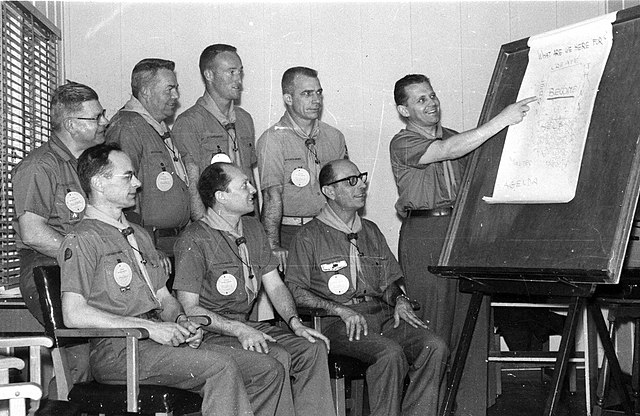Wood Badge (Boy Scouts of America)
Wood Badge in the United States is an advanced level leadership training available to adult Scout leaders. The first Wood Badge course was presented in England by the founder of Scouting, Baden-Powell, and he introduced the program into the United States during a visit in 1936. The first course was held at the Mortimer L. Schiff Scout Reservation, but Americans did not fully adopt Wood Badge until 1948. The National BSA Council staff provided direct leadership to the program through 1958, when the increased demand encouraged them to permit local councils to deliver the training.
Wood Badge beads, woggle and neckerchief
1962 Wood Badge staff meeting on the Monterey Peninsula. Front row, L-R Joe McConnell, Alex Szaszy, Tiz Urbani, Bela Banathy; Back row, L-R Joe St. Clair, William "Bill" Sutcliffe, Bob Bowman, Tom Moore. Flipchart says: "What are we here for? Create, Think, Help, Learn, BECOME"
Joe St. Clair, Fran Peterson, Maury Tripp, and Béla H. Bánáthy at the White Stag Leadership Development Program Indaba held at Fort Ord, California, during November 1968. St. Clair, Peterson, and Bánáthy led Course #25-2 over four weekends in January and February 1968 at Fort Ord, one of six experimental Wood Badge courses held nationwide.
Wood badge regalia
Colonel John Skinner "Belge" Wilson (1888–1969) was a Scottish scouting luminary and friend and contemporary of General Baden-Powell, recruited by him to head the International Bureau, later to become the World Bureau of the World Organization of the Scout Movement. Wilson was acting director from 1938 to 1939 following the death of Hubert S. Martin; he was elected in 1939 and remained in office until 1951. He then became Honorary President of WOSM for four years.
Robert Baden-Powell and J.S. Wilson during the 4th World Jamboree held in Gödöllő, Hungary (1933).





